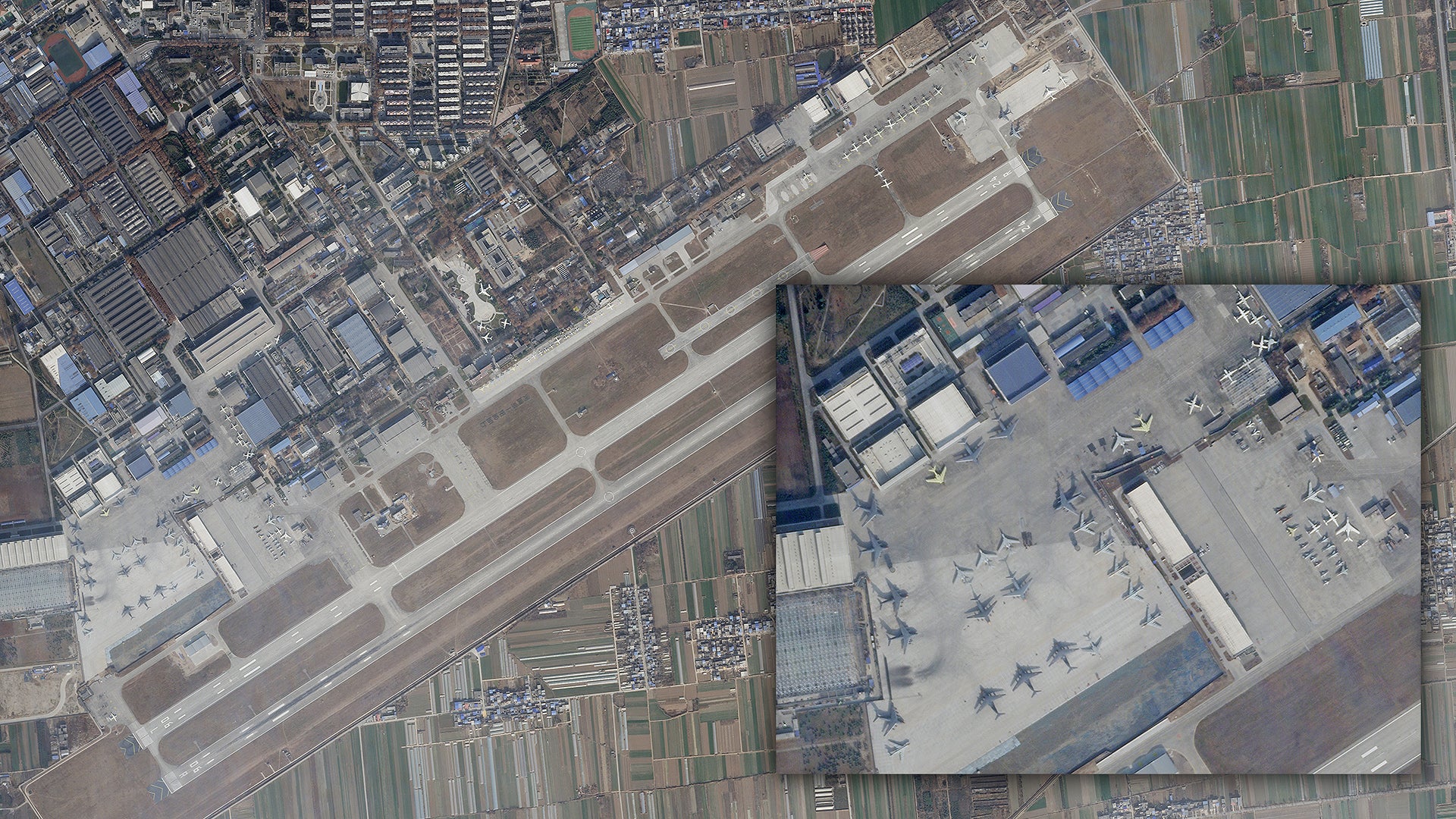Xi’an Aircraft Company, which makes China’s most prominent large aircraft, among other responsibilities, has its primary plant located at the sprawling Yanliang Air Base that also houses China’s Flight Test Establishment, as well as academic institutions that deal with aircraft design. Beyond being a strategic production line for China’s aerospace industry, the installation supports testing for the vast majority of aircraft within the People’s Liberation Army’s stable and executes avionics and other systems integration work for those aircraft. As of late, Xi’an has been building China a fleet of airlifters that can help make its geopolitical aspirations abroad a reality, as well as providing updated long-range bombers to support its emerging anti-access military strategy.
In a high-resolution satellite image we exclusively obtained from Planet Labs that was taken just 48 hours ago, the breakneck pace of Y-20 strategic transport production is abundantly clear. The photo of the base includes no less than 20 Y-20s, the most we have ever seen at the installation based on a number of high-resolution images available for review that span a number of years.

Although it is far less exciting than its indigenous fighter jet counterparts, the Xi’an Y-20 is just as, if not more important, when it comes to China realizing its extra-territorial ambitions. Being able to haul outsized loads over international distances with an aircraft that does not rely primarily on support from foreign entities gives Beijing the high-speed logistical reach it needs to support its growing number of bases and military engagements far beyond the Chinese mainland. In other words, the Y-20 is essential to China’s core foreign policy and defense strategy.

Like many Chinese military aircraft designs, the main limitation for the Y-20, which is loosely analogous to the C-17, remains its engines, which are currently Russian low-bypass Soloviev D-30KP-2 turbofans. The goal is to equip the type with the indigenous WS-20 high-bypass turbofan that will allow the aircraft design to reach its maximum potential and rid the type of any significant foreign dependence. Flight testing is underway to do just that, but the WS-20 isn’t slated for production until 2024, and that is just an estimated timetable. Regardless, the fact that China is punching these airlifters out at a seemingly dizzying rate underlines its foreign policy objectives and the growing might of the Chinese military overall. Also, it is worth noting that the U.S. no longer has a strategic airlifter in production after shuttering the C-17 plant in Long Beach after the last C-17 rolled off its line in 2015.

Also seen scattered about the base are 17 Xi’an H-6 bombers. Now in its drastically upgraded H-6K form, along with its derivatives, these bombers, which draw their design lineage from the 1950s Soviet Badger, are the backbone of the People’s Liberation Army’s long-range aviation enterprise and perform a large variety of roles beyond traditional bomber and cruise missile delivery missions. These include acting as the mothership for outsized high-speed drones and massive air-launched ballistic missiles. Until China’s stealthy bombers come online in the future, the H-6 will represent the tip of the airborne strategic spear for the PLA and clearly Beijing is investing in the platform accordingly.

The images also shows four KJ-500 airborne early warning and control (AEW&C) aircraft that will bolster China’s growing radar plane fleet. The aircraft are huge force multipliers to the country’s fighters and ground and sea-based air defense systems. A fifth AEW&C aircraft can be seen on the northwestern portion of the base tucked into a corner. It appears to be a testbed aircraft that uses a Y-7 twin-engine turboprop transport as a platform. This test aircraft is supposedly designated JZY-01 and you can read more about it here.

Another unique resident that calls the base home is China’s own “Catfish” testbed jet used for avionics development for the J-20 in a similar fashion to how Boeing used its first production 757 for a similar cause in developing and sustaining the F-22 Raptor. That aircraft, which you can read our full profile on here, is seen at the far eastern edge of the ramp. To the north of the general eastern ramp area, it appears that construction is underway to add more hangar facilities along the huge flight line.

Beyond that, an array of other turboprop aircraft, most notably Xi’an MA60s and Y-7s, as well as light aircraft and fighters, are also present. The fighter contingent ranges from antique Shenyang J-6s to newer Flanker derivatives, such as the J-11. The base has a rotating assortment of front-line fighter visitors that go there for testing and systems integration work. Handfuls of J-10s and J-20s occupying parts of the ramp are not uncommon.


It isn’t clear, but the base could do some drone conversions for older fighter types, as well. The most interesting airframes seen are elongated delta-winged jets that are painted a burnt orange color. These are likely J-8 Finbacks have been converted to full-scale target drones, similar to the QF-4 and QF-16s in the United States.

Yanliang Air Base truly sits at the center of China’s most important aircraft developments and the immense activity there serves as yet another glaring reminder that Beijing’s military might seems to be on a nearly exponential growth curve.
Contact the author: Tyler@thedrive.com
